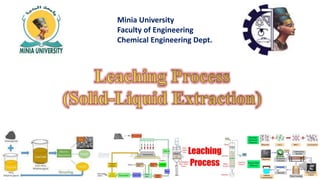35162الثامنهLeaching_Lecture.ppt
•Télécharger en tant que PPT, PDF•
0 j'aime•13 vues
Leaching
Signaler
Partager
Signaler
Partager

Recommandé
Recommandé
For B.Pharm, 5th SemesterExtraction and isolation of phytoconstituents

Extraction and isolation of phytoconstituentsGovernment Pharmacy College Sajong, Government of Sikkim
Contenu connexe
Similaire à 35162الثامنهLeaching_Lecture.ppt
For B.Pharm, 5th SemesterExtraction and isolation of phytoconstituents

Extraction and isolation of phytoconstituentsGovernment Pharmacy College Sajong, Government of Sikkim
Similaire à 35162الثامنهLeaching_Lecture.ppt (20)
Methods of Extraction, Pharmacognosy, types of extraction for herbal drugs

Methods of Extraction, Pharmacognosy, types of extraction for herbal drugs
Dernier
https://app.box.com/s/7hlvjxjalkrik7fb082xx3jk7xd7liz3TỔNG ÔN TẬP THI VÀO LỚP 10 MÔN TIẾNG ANH NĂM HỌC 2023 - 2024 CÓ ĐÁP ÁN (NGỮ Â...

TỔNG ÔN TẬP THI VÀO LỚP 10 MÔN TIẾNG ANH NĂM HỌC 2023 - 2024 CÓ ĐÁP ÁN (NGỮ Â...Nguyen Thanh Tu Collection
https://app.box.com/s/x7vf0j7xaxl2hlczxm3ny497y4yto33i80 ĐỀ THI THỬ TUYỂN SINH TIẾNG ANH VÀO 10 SỞ GD – ĐT THÀNH PHỐ HỒ CHÍ MINH NĂ...

80 ĐỀ THI THỬ TUYỂN SINH TIẾNG ANH VÀO 10 SỞ GD – ĐT THÀNH PHỐ HỒ CHÍ MINH NĂ...Nguyen Thanh Tu Collection
Dernier (20)
General Principles of Intellectual Property: Concepts of Intellectual Proper...

General Principles of Intellectual Property: Concepts of Intellectual Proper...
Salient Features of India constitution especially power and functions

Salient Features of India constitution especially power and functions
Plant propagation: Sexual and Asexual propapagation.pptx

Plant propagation: Sexual and Asexual propapagation.pptx
Basic Civil Engineering first year Notes- Chapter 4 Building.pptx

Basic Civil Engineering first year Notes- Chapter 4 Building.pptx
Jual Obat Aborsi Hongkong ( Asli No.1 ) 085657271886 Obat Penggugur Kandungan...

Jual Obat Aborsi Hongkong ( Asli No.1 ) 085657271886 Obat Penggugur Kandungan...
HMCS Max Bernays Pre-Deployment Brief (May 2024).pptx

HMCS Max Bernays Pre-Deployment Brief (May 2024).pptx
Unit 3 Emotional Intelligence and Spiritual Intelligence.pdf

Unit 3 Emotional Intelligence and Spiritual Intelligence.pdf
This PowerPoint helps students to consider the concept of infinity.

This PowerPoint helps students to consider the concept of infinity.
NO1 Top Black Magic Specialist In Lahore Black magic In Pakistan Kala Ilam Ex...

NO1 Top Black Magic Specialist In Lahore Black magic In Pakistan Kala Ilam Ex...
TỔNG ÔN TẬP THI VÀO LỚP 10 MÔN TIẾNG ANH NĂM HỌC 2023 - 2024 CÓ ĐÁP ÁN (NGỮ Â...

TỔNG ÔN TẬP THI VÀO LỚP 10 MÔN TIẾNG ANH NĂM HỌC 2023 - 2024 CÓ ĐÁP ÁN (NGỮ Â...
Beyond_Borders_Understanding_Anime_and_Manga_Fandom_A_Comprehensive_Audience_...

Beyond_Borders_Understanding_Anime_and_Manga_Fandom_A_Comprehensive_Audience_...
80 ĐỀ THI THỬ TUYỂN SINH TIẾNG ANH VÀO 10 SỞ GD – ĐT THÀNH PHỐ HỒ CHÍ MINH NĂ...

80 ĐỀ THI THỬ TUYỂN SINH TIẾNG ANH VÀO 10 SỞ GD – ĐT THÀNH PHỐ HỒ CHÍ MINH NĂ...
Python Notes for mca i year students osmania university.docx

Python Notes for mca i year students osmania university.docx
HMCS Vancouver Pre-Deployment Brief - May 2024 (Web Version).pptx

HMCS Vancouver Pre-Deployment Brief - May 2024 (Web Version).pptx
35162الثامنهLeaching_Lecture.ppt
- 1. Minia University Faculty of Engineering Chemical Engineering Dept.
- 2. Minia University Faculty of Engineering Chemical Engineering Dept.
- 3. 1 Definition Of leaching. 2 Example Of Leaching Process. 3 Principle Of Leaching Process. 4 Uses Of Leaching
- 4. Is a process of mass transfer that occurs by extracting a substance from a solid material that has come into contact with a liquid. In leaching, the liquid is very important as it facilitates the ability to remove (or extract) a given substance from a solid matrix (i.e. material).
- 5. A simple example is the making of green tea. Now, relate the component used in the green tea to our definition. 1- the green tea bag is our solid mixture. 2- the green to be extracted is our desired substance. 3- and the hot water is our liquid source.
- 7. 1- to add hot water to a cup. 2- and now, steep the green tea bag into it. 3- not only the color changes but also the green is extracted from the bag into the cup. 4- and after steeping some the take a sip from the cup there is not only hot water but a delicious green tea. Making tea is an ideal example of how leaching works. The process goes like that:
- 8. Leaching can be batch, semi batch, or continuous. It usually operates at an elevated temperature to increase the solubility of the solute in the solvent. Feed to leaching system typically is solid, consisting of basically insoluble carrier material and a (Usually desirable) soluble compound. The feed usually must be prepared by grinding or chopping. It is then mixed with a liquid solvent. The desired material dissolves (to some extent) and so leaves when the liquid is drawn off as overflow.
- 9. Typical uses include: In the metals industry for removing mineral from ores (acid solvents). Int the sugar industry for removing sugar from beets (water is solvent). In the oilseeds industry for removing oil from soybeans, etc. (hexan or similar organic solvents).